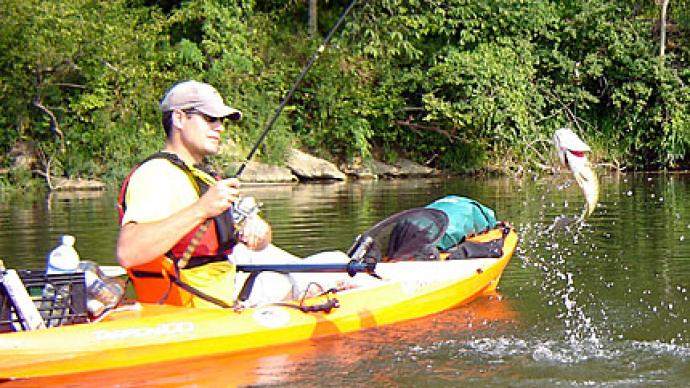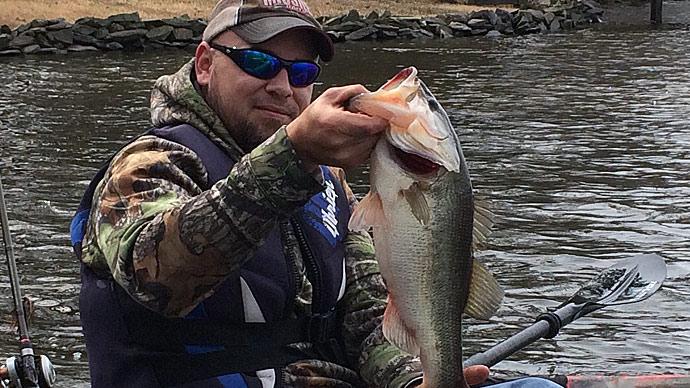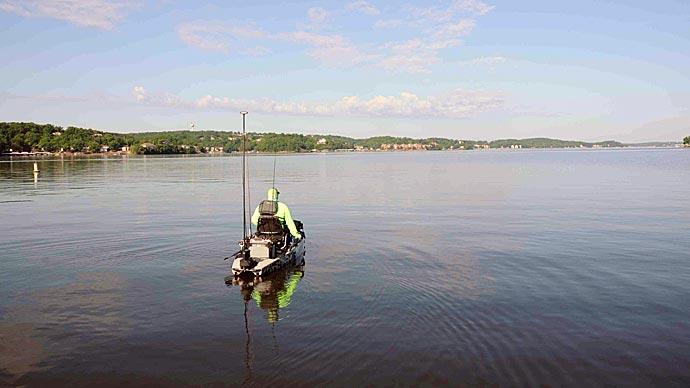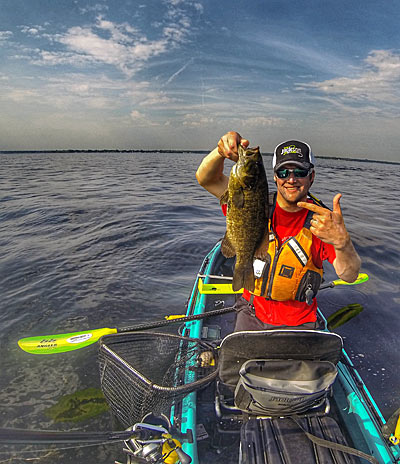
When kayak angler Noah Heck gazes across open water, he sees plenty of promise. “I get excited about the potential of fishing water that may not have been fished out,” he said. “It’s more exciting than a bank to me. Also, I love knowing every cast could be a monster fish.”
Open water is unchartered territory for many kayak anglers and a good reason. They are more exposed to wind and waves, making fishing and paddling difficult and sometimes unsafe for smaller watercraft. Reaching and fishing also require covering more water, which takes time and energy when paddling. But that doesn’t deter Heck, especially when it’s time to catch summer smallmouth.
Living in Pittsburgh puts Heck within easy reach of some of the country’s best open-water smallmouth fishing. “I fish several big waters,” he said. They include Lake Erie, especially outside Presque Isle Bay in his home state of Pennsylvania, and Lake St. Clair, where he caught more than 50 open-water smallmouth in four hours during a two-day tournament. And when the calendar turns to July, he knows he’ll be paddling away from shore on all of them.
Most smallmouth bass in these waters are post-spawn in July, though it’s not unusual to still find a few spawning. Water temperatures remain relatively cool; it takes a long time for so much water to warm. It also takes time to find the spots that attract them, said Heck, the 2018 overall angler of the year and advisor of Kayak Anglers, a tournament organization that counts more than 400 members in Pennsylvania, New York, Ohio, and Indiana. “In Lake St. Clair, there is so much of the bottom that has nothing to it — no weeds, no rock,” he said. “You’re kind of lost out there fishing only a sandy bottom.”
Instead, Heck searches out minor differences such as a small group of rocks or a patch of aquatic vegetation. Even a slight depth change can attract summer smallmouth. “Those fish don’t have many options,” he said. “They have to use what they have.”
Get to them
Many of today’s fishing kayaks sport a wide beam. That creates enough stability in many cases to allow anglers to stand comfortably while fishing. But that stability comes with a cost — it takes more effort to paddle. Instead of a snow plow, you need an arrow when venturing into open water.
Fishing open water involves covering lots of water, whether getting to it or moving among spots once there. At a recent tournament on New York’s Oneida Lake, for example, Heck paddled 14 miles in search of the lake’s famous smallmouth. And because he’s the engine, he wants to accomplish that as efficiently as possible. So, he chooses a narrow kayak that tracks well. “I’d rather have the offshore style kayak and give up the standing in favor of easier paddling,” he said.
Heck’s current kayak is a Jackson Kraken. It’s 15 and a half feet long and has a 30-inch beam. He said even with a paddle blade up in the wind, its slim stature makes the most of each paddle stroke.
Kayaks provide other benefits in today’s waters, where bass feel more fishing pressure than ever. Heck said bass are in tune with their environment and can sense when a traditional boat — motor props whirling, electronics pinging, and water being displaced — is nearby. He said kayaks lack most of that commotion, which keeps them from spooking bass, especially in the clear-water fisheries he frequents. They have less mass, which disturbs less water. And there’s less prop wash — at least with paddle-powered kayaks — and being made of plastic, he said dropping something doesn’t bring a loud thud, like in an aluminum boat, that would be transmitted through the water.
Find them
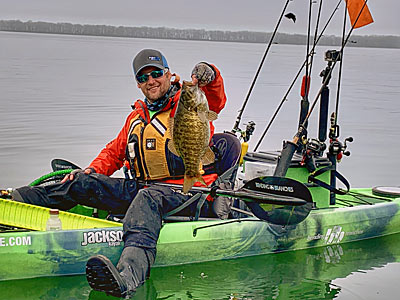
The farther you fish from shore, the more critical your electronics become. They are the only way you can find structure, cover, and smallmouth with few visual clues. But Heck said that doesn’t mean you need the most expensive or largest ones. He suggests finding a unit that makes the most of your battery’s charge while creating an accurate image of the bottom. And the screen only needs to be big enough to see where you’re seated.
Heck splits the screen on his Raymarine Dragonfly 7PRO between down scan, which separates fish and cover, and traditional 2-D sonar, which does a better job of revealing small patches of aquatic vegetation. He’ll pull up its Navionics charts to search for and mark subtle spots. And if he sees something especially interesting, he can stream sonar data to his smartphone or tablet, where it can be shared, saved, and reviewed over and over.
Heck gets upward of three full fishing days from one full charge of his lithium-ion battery, which is about the size of two wallets stacked on top of each other. That takes up less space and adds fewer pounds than the batteries most kayak anglers have been using.
With so much open water to cover, Heck stays on the move. He prefers to drift, using a drift sock to keep his progress at a reasonable rate. He uses one designed for boats 15 feet or shorter. Drifting along also creates the right speed for his electronics to get a good read on the bottom.
Along the way, Heck targets summer smallmouth with a host of finesse lures such as drop shots and tubes. He rigs them with as little weight as possible. “When I throw light finesse stuff, I want just to feel the bottom,” he said. When he feels a bite, he opens the bail on his spinning reel and drifts past the spot. Once he is casting distance away, he stops his drift with a quick paddle stroke. That keeps him from spooking any school of smallmouth.
Heck also watches his electronics for any small spot that might attract smallmouth. When he comes across one, he’ll add a waypoint, then move away from it, like when he gets a bite, so he can cast back at it.
Stay on them
Heck is honest: It takes practice to develop the paddle skills to hover a kayak over a spot. But in time, he said, it becomes second nature, as easy as using a foot-controlled electric trolling motor on a traditional bass boat. It’s easy for him now to hold a paddle in one hand and a fishing rod in the other. But he also relies on outside help.
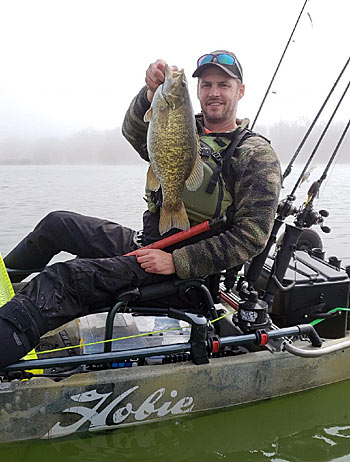
Open-water fishing doesn’t always involve deep water. Shoals and flats are found there, too, and they can be covered with summer smallmouth. If Heck is fishing water less than 7 feet deep, he’ll peg his kayak with an anchor pole such as Bernie’s River Stick. It’s lowered and raised manually with a system of pulleys. He said a second option is a Power-Pole Micro Anchor, which replaces rope and pulleys with an electric motor.
A less expensive but equally effective option is an anchor. He suggests running about 50 feet of line from a 5-pound mushroom-style anchor — which works in all but the stiffest winds — through a low-profile Anchor Wizard manual winch. When you’re at your destination, send the anchor to the bottom, using the Wizard’s crank to tighten up any slack. “And when you want to move, you just crank it up,” he said. "The system doesn’t add noticeable weight," he said, "a benefit when paddling open-water distances."
Heck admits that pedal-powered kayaks make it easier to cover water. They also might provide a slight advantage for fishing a single spot. He said, in theory, slowly pedaling into the wind should keep the kayak in one spot. And with some practice, that can be accomplished. But when it’s time to fish closer to the bank, he feels a paddle creates faster starts, stops, and turns around obstacles such as laydowns, docks, and standing timber.
Pedals and paddles aren’t the only means of kayak propulsion. Medium and deep-diving crankbaits, for example, create enough water resistance during a retrieve to move a kayak in the direction they are cast. “I do that with a spinnerbait, too,” Heck said. “Sometimes that’s a good thing.”
Return home
Big water demands respect. Weather can change without warning, so Heck said it’s vital to know your limitations — kayak and paddling ability. As he paddles farther from shore, he continually asks himself one question: “Would I be able to get this kayak back to shore?”
One real danger is capsizing, and Heck said your preparations should include preparing for that emergency. You must test what it takes to dump your kayak and, more importantly, what you need to do to get back in it. It won’t be easy to try it during an emergency, especially in waves, wind, and chilly temperatures. “It’s a lot different when it happens to you,” he said. Practicing on a warm, nice day in protected shallow water is best.
Heck takes other precautions. He adds a float to his smartphone, and he keeps closed the lids on his tackle boxes. His rods are leashed to his kayak; that also saves them when fishing under obstacles such as low tree branches and docks, where they can catch and be pulled overboard, sometimes without the angler even knowing. And when the weather is cold, he packs a dry bag with a change of clothes, fire-starting equipment, wool socks, and gloves.
Heck said one way of lowering the risk of something going wrong is practicing how you land, and if you’re fishing a tournament, record your catches. Repetition makes reaching for a ruler, identifier, and smartphone second nature.
Heck is a big proponent of using a landing net. He uses a Boga Grip handling tool inside his net, corralling a bass while he gets everything ready to measure it. And leaving the bass submerged in the net gives it time to relax, creating less stress for him and the bass.


